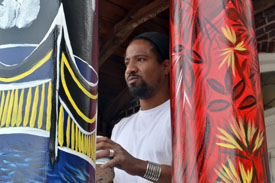Artist Ricardo Basilio Coke’s mural depicts all the cultures of Hispanic America

“Normally, I’ll paint on the ground,” said the artist, Ricardo Basilio Coke. “I’ll frame a mural out on the ground, paint it, and then hang it up. Painting on the ground gives me a nice, 360-degree view of the piece. But I couldn’t do that this time.”
This time, Coke’s commission was to paint a mural depicting all the cultures of Hispanic America, and the only way to do that was to use every square inch of surface area on the portico – that meant the door frame, the interior and exterior of the roof structure, and the surfaces of the 10 columns that hold up the roof.
Coke’s mural replaces an older mural, painted on the portico in 1995. That mural, and the portico itself, were falling apart.
“We had an arts conservator assess the old mural to see if we could save it,” said Carlos Fernandez, director of the center. But it couldn’t be salvaged, because large parts of the old mural had detached from the wood.
Fernandez, his staff and the members of the CLAC advisory board were familiar with Coke’s work because he had worked as an artist-in-residence at schools in New Brunswick. They told him to use the entire space on the portico – columns, ceiling, door frame, and the arch. The previous mural had included images of masks from Latin American indigenous cultures, and they wanted to have those cultures and masks represented in Coke’s work.
“We also asked him to think about immigrants coming to the United States from different Latin American countries, moving from rural and urban landscapes to the east coast,” Fernandez said. The board members also spoke to Coke about the range of art in which they develop programs, from photography exhibits and visual arts exhibitions to performing arts and poetry.
Coke set to work in August. The weather got in the way, and Hurricane Irene brought Coke’s work to a halt. At this writing, however, he has only to finish the arch and the ceiling.
“What makes this mural different is that I’m using my own style, a style I’ve been working on for six or seven years, and it’s influenced by the textile work of Kuna Indians from Panama,” said Coke, who was born in Panama and claims Kuna ancestry through his mother’s family. “It’s called mola, and it involves the layering of different colors to create different textured backgrounds and figures. My work reproduces that style pictorially.”
Using that style, Coke nonetheless manages to pay homage to native and Hispanic culture from nearly every country in Latin America. On its 10 columns, the mural depicts time – both historical and cyclical – as well as culture, from indigenous civilizations to the arrival of the Spaniards to independence, revolution, and immigration.
The mural also interprets the Hispanic experience in the United States. The World Trade Center is there, and so are bridges. The bridges are metaphorical as well as physical, Coke says, because they represent connections between cultures and between the present and the past.